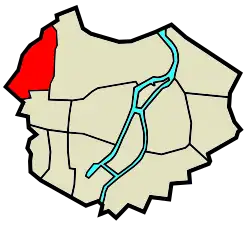Grodzisko, Gdańsk
Grodzisko | |
|---|---|
Quarter (osiedle) | |
Historic buildings in Grodzisko | |
 Grodzisko within Śródmieście | |
| Coordinates: 54°21′24″N 18°38′25″E / 54.3567°N 18.6404°E | |
| Country | Poland |
| Voivodeship | Pomeranian |
| City | Gdańsk |
| District | Śródmieście |
| Incorporated into Gdańsk | 1454 |
Grodzisko, historically known as Góra Gradowa (German: Hagelsberg; Kashubian: Gradowô Góra), is a quarter (osiedle) of Śródmieście, a district of Gdańsk.
History
Grodzisko was initially home to a stronghold guarding the city of Gdańsk, a role it served as early as the 9th century. By 1392, it had been further developed with gardens, and became part of Gdańsk in 1454.[1] It was progressively militarized, with an instance of it being used for military purposes being during the Danzig rebellion in 1577. It was also a fort of François Joseph Lefebvre during the siege of Danzig in 1807.[2]
Military use of Grodzisko, known in German as Hagelsberg, continued up to 1973, including as a base for anti-aircraft warfare during World War II. After the war, it was used as a location for military radio broadcasting. In 1973, an initial project for repurposing the area was proposed, with the idea being to create a new Youth Centre of Culture, but this was not realized. Since 1997, Grodzisko has been occupied by a public park, as well as Hevelianum, a museum. The most significant recent addition is the completion of the Cross of Two Millennia of Christianity and a Millennium of Gdańsk in 2000.[3]
References
- ^ "Jednostki morfogenetyczne Gdańska". gis.gdansk.pl. Archived from the original on 15 May 2008. Retrieved 16 July 2025.
- ^ Lipka, Michał (24 June 2014). "Historia o Danie, Grafie Majowym i Górze Gradowej". trojmiasto.pl. Retrieved 16 July 2025.
- ^ Januszajtis, Andrzej. "GRODZISKO". Gedanopedia. Retrieved 16 July 2025.